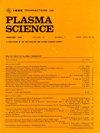低分辨干涉图中高能量密度等离子体电子密度的神经网络重建
IF 1.5
4区 物理与天体物理
Q3 PHYSICS, FLUIDS & PLASMAS
引用次数: 0
摘要
干涉测量法通过比较经过等离子体的激光束与参考光束之间的相移,可以精确地测量高能量密度等离子体的电子密度。虽然实际相移是连续的,但测量的相移具有不连续性,因为它的测量被限制在$-\pi $和$\pi $之间,这种效应称为“包裹”。尽管已经开发了许多方法来恢复原始数据,但“未包裹”相移、噪声和采样不足往往会阻碍其有效性,这需要先进的算法来处理不完美的数据。分析干涉图本质上是一种模式识别任务,径向基函数神经网络(RBFNNs)在这方面表现出色。这项工作提出了一个网络架构,旨在解开相位干涉图,即使在存在显著的混叠和噪声。该方法的关键方面包括三个阶段的学习过程,依次消除相位不连续,直接从数据中学习的能力,而不需要大的训练集,简单地掩盖丢失或损坏数据的区域的能力,以及并行的Levenberg-Marquardt算法(LMA),该算法使用局部网络聚类和全局同步来加速计算。本文章由计算机程序翻译,如有差异,请以英文原文为准。
Neural Network Reconstruction of the Electron Density of High Energy Density Plasmas From Under-Resolved Interferograms
Interferometry can accurately measure the electron density of a high energy density plasma by comparing the phase shift between a laser beam passing through the plasma and a reference beam. While the actual phase shift is continuous, the measured shift has discontinuities, since its measurement is constrained between $-\pi $ and $\pi $ , an effect called “wrapping.” Although many methods have been developed to recover the original, “unwrapped” phase shift, noise and under-sampling often hinder their effectiveness, requiring advanced algorithms to handle imperfect data. Analyzing an interferogram is essentially a pattern recognition task, where radial basis function neural networks (RBFNNs) excel. This work proposes a network architecture designed to unwrap the phase interferograms, even in the presence of significant aliasing and noise. Key aspects of this approach include a three-stage learning process that sequentially eliminates phase discontinuities, the ability to learn directly from the data without requiring a large training set, the ability to mask regions with missing or corrupted data trivially, and a parallel Levenberg-Marquardt algorithm (LMA) that uses local network clustering and global synchronization to accelerate computations.
求助全文
通过发布文献求助,成功后即可免费获取论文全文。
去求助
来源期刊

IEEE Transactions on Plasma Science
物理-物理:流体与等离子体
CiteScore
3.00
自引率
20.00%
发文量
538
审稿时长
3.8 months
期刊介绍:
The scope covers all aspects of the theory and application of plasma science. It includes the following areas: magnetohydrodynamics; thermionics and plasma diodes; basic plasma phenomena; gaseous electronics; microwave/plasma interaction; electron, ion, and plasma sources; space plasmas; intense electron and ion beams; laser-plasma interactions; plasma diagnostics; plasma chemistry and processing; solid-state plasmas; plasma heating; plasma for controlled fusion research; high energy density plasmas; industrial/commercial applications of plasma physics; plasma waves and instabilities; and high power microwave and submillimeter wave generation.
 求助内容:
求助内容: 应助结果提醒方式:
应助结果提醒方式:


